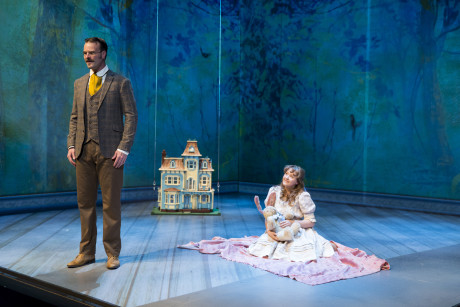Playwright Jennifer Haley has seen the future and it’s The Nether, her cerebrally chilling thriller about future tech and future sex. Just opened at Woolly Mammoth Theatre Company in a fantastical production directed by Shana Cooper, The Nether sets off brain bombs like there’s no tomorrow.

Imagine, if you will, a 3D virtual world where men’s most twisted sexual compulsions have free rein. A cyberspace where cybersex is so advanced, the simulated sex objects seem sensate. A private digital retreat for consensual role play and dark desires unmoored to social mores. A place where men with tendencies toward children can pursue their bent beyond the reach of real-world laws. The perfect personal playground for customized erotic imaging where no actual human bodies are abused, no fetishized flesh is wounded, no fuck toys are trafficked. It’s only electronic ones and zeros. A harm-free, value-neutral programmed pornland for the mind.
Or is it?
Haley’s ingenious script rips into that thicket of ethical issues and keeps us on mental tenterhooks with one of the most spellbinding theatrical head trips of our time.
The play opens with a real-world interrogation in progress into shady goings-on in the virtual world. The investigator, Morris (a tersely toughminded Gabriela Fernandez-Coffey) is embarked on an initiative to impose real-world law on virtual-world licentiousness. To that end she questions an entrepreneurial procurer named Sims (a rivetingly unravelling Edward Gero) about his lucrative Hideaway, a beautiful Victorian-themed locale he has programmed in “the Nether” where men from the real world pay him to enter as “shades.” Once there they can do whatever they want to compliant convincing children who are actually digitized avatars operated from afar by adult “behinders.”
MORRIS: But really, Mr. Sims, an average of fourteen hours a day in the Nether? What can be gained by spending so much time in something that isn’t real?!
SIMS: Just because it’s virtual doesn’t mean it isn’t real….As the Nether becomes our contextual framework for being, don’t you think it’s a bit out of date to say it isn’t real?
Within this shrewd setup Haley propels an unnerving story that moves back and forth between the interrogation room and the Hideaway, where we meet Sims as his avatar Papa (wearing a sharp all-white suit by Costume Designer Kelsey Hunt) and his favorite faux child, a giggling, sexually precocious nine-year-old girl named Iris (the fascinatingly nuanced Maya Brettel). Also dropping by the Hideaway is a reluctant customer named Woodnut (Tim Getman, who’s got an inimitable knack for playing appealing and appalling). With Papa’s smarmy encouragement, Woodnut’s innocent-seeming dalliance with Iris gets dark before our eyes.
Back in the investigation room, Morris grills a disheveled 65-year-old retired professor named Doyle (Paul Vincent O’Connor, who reveals the character’s unfolding surprises with touching depth). Believing Doyle has incriminating information on Sims, she confronts him:
MORRIS: People meet as physical beings in the Nether.
DOYLE: But there are no longer physical barriers to that contact…. Can’t you see what a wonder it is that we may interact outside our bodies?!
MORRIS: But who are we when we interact without consequence?
Some of Haley’s scenes in the real world play like captivating arguments, with characters in moral combat. And some in the virtual world, especially the scenes of seductive child’s play, are so prettily creepy you could hear a pin drop on opening night.
The super-smart script is supported by a dazzling production. Set Designer Sibyl Wickersheimer creates two distinct worlds that shift back and forth in the blink of an eye. Lighting Designer Colin K. Bills keeps the real world harsh and bathes the virtual world in beauty. Sound Designer Eric Shimelonis astonishes our ears, as the play does our conscience. And Projections Designer Jared Mezzocchi creates absolutely magical background imagery, including birds in flight in an enchanting forest.

I doubt there is another more important and portentous play about our online future than The Nether. And having been blown away by the Woolly Mammoth production, I’m not so sure that future is not already now.
Running Time: 80 minutes, with no intermission.
The Nether plays through May 1, 2016 at Woolly Mammoth Theatre Company – 641 D Street, NW, in Washington, DC. For tickets, call the box office at (202) 393-3939, or purchase them online.
LINKS:
‘The Nether’ at Woolly Mammoth Theatre Company reviewed by David Gerson
Magic Time! ‘The Nether’ at Woolly Mammoth Theatre Company by John Stoltenberg.
Spine: ‘The Nether’ and its Virtual Revolution at Woolly Mammoth Theatre by Robert Michael Oliver.
The Nether deals with adult themes and is not appropriate for children under the age of 16.





